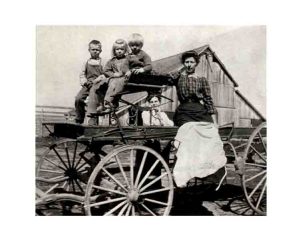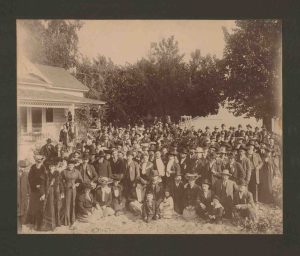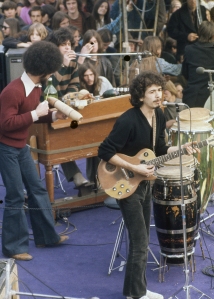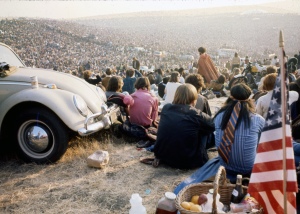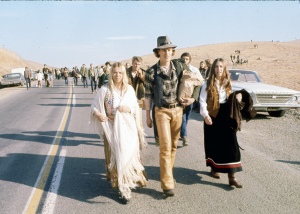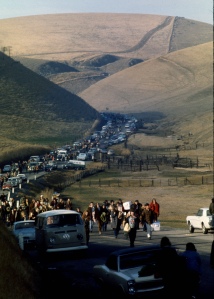A Self-Guided Walking Tour of Pleasanton’s Haunted Downtown
 Pleasanton, California in the 1850’s was called “The Most Desperate Town in the West”. Main Street was home to brothels, gambling halls and bandits. Below the quaint streets of Pleasanton runs an old tunnel that was built by the Chinese in the late 1800’s. While it was constructed to move goods from store to store and also to move about town after curfew, the tunnel is now reportedly filled with ghosts.
Pleasanton, California in the 1850’s was called “The Most Desperate Town in the West”. Main Street was home to brothels, gambling halls and bandits. Below the quaint streets of Pleasanton runs an old tunnel that was built by the Chinese in the late 1800’s. While it was constructed to move goods from store to store and also to move about town after curfew, the tunnel is now reportedly filled with ghosts.
It’s no surprise that the many of the historic buildings in the town have reported seeing ghosts, strange lights and other haunted activities. The most common occurrences are sightings of people, sounds of footsteps or muffled voices, objects that move, doors opening and closing or lights turning on and off.
The tour begins at one of the oldest buildings in town.

Have a margarita here and you may have a ghostly eavesdropper.
Haunt 1: 625 Main Street, Blue Agave Restaurant
Many visitors to Pleasanton have enjoyed a margarita on the patio of this Mexican restaurant. But few know the haunted history of this building. One of the oldest buildings in town, it was originally a home for the Arendt family.
The School district had their offices here before this was a restaurant. There were stories of papers suddenly flying around the office for no reason and desk chairs rolling around the office mysteriously.
The staff at the restaurant has noticed noises and doors closing over the years. When the present owners remodeled the restaurant and upstairs area, one of them saw an apparition of a young girl, who then mysteriously disappeared.
A psychic reading indicated that Mr. Arendt is still in the house and is the dominant spirit. The other ghosts are people that worked for him in the home. The psychic reported that the other ghosts like to eavesdrop on conversations and sit on the porch, watching the townspeople pass by. They love having the house to themselves after the business closes. Then they have parties and just ignore Mr. Arendt.
Haunt 2: 335 St. Mary Street, Salon Esencia
This is John Amaral’s house-built in the early 1930’s.There have been various sightings over the years of a man in a white shirt and black suspenders looking in the windows and crossing the yard between the two structures on the property. Reports of items disappearing or being displaced, metal trays in the microwave in the morning, lids on pots rattling for no known cause, large bags of towels repeatedly falling off the shelves, motion detectors being set-off when no one is in the building, and recurring water spots on the carpet in a particular place. There have been a number of businesses in this building over the last 30 years and similar stories have been passed down from one tenant to another.
Haunt 3: 807 Main Street, The Rose Hotel
Ever wanted to spend the night in a haunted hotel? Check in to The Rose Hotel, which has had many ghostly sightings. The building began its life as a general merchandise store, then an indoor golf course. One particularly scary story comes from when the business was a charity shop. An employee was in the basement working when the lights went off 3 times, she heard 3 bangs or knock, and then saw a man walk down the stairs and thru the basement wall. Many other employees also had experiences with the ghosts. They believed that the ghosts were roaming the tunnels under Main Street. The ghosts remained behind even after the demolition of old building and continue to haunt the new Rose Hotel. The hotel reports that the spirits have moved a heavy set of lockers out from the wall. Exit doors have sensed that someone left the hotel, but the security cameras don’t pick up anything.

Does the Pleasanton hotel have a ghost that roams the upstairs offices?
Haunt 4: 855 Main Street, The Pleasanton Hotel & The Farmer Restaurant
While you can’t stay at the Pleasanton Hotel, you can dine there at the Farmer Restaurant. This haunted spot was a favorite of gamblers and prostitutes. If fact, during the 1950’s the building was owned by Paul “Bouquet” Cohn, the brother of infamous gangster Mickey Cohn.
The famous ghostly resident of the hotel is a prostitute who was murdered in 1870. She continues to haunt the establishment to this day. Tenants on the top floor of the building have reported that a cold spot where she near where she died. Others have heard footsteps, reported instances of not being able to open their doors as if someone is holding it shut and have felt like someone is watching them.
Haunt 5: 200 Ray Street, Historic Kottinger Barn
In it’s latest reincarnation, the barn is Milfleur, a floral and gift shop. Built in 1852, the barn was used as a jail by Justice of the Peace John Kottinger. Unfortunately, their gangs were busting bandits out of custody on the way to the courthouse. To stop this from happening Kottinger built a 500 ft tunnel from his home to the jail, in order to secretly move prisoners to and from court so that their friends would not try to free them. According to psychic owner Teri Carlson, there at least twenty ghosts in the barn, including John Kottinger. Reportedly the ghosts are cattle rustlers, bandits and criminals that were hanged or died while in custody.
Haunt 6: 670 Main Street, Clover Creek
This quaint shop on Main Street has a Native American woman spirit haunting the aisles. A psychic reading indicated that the spirit was sad and lonely, and that a large group of men brought her here with her family and many other people from her tribe. Her children and husband died, and she is worried that the strange men won’t let her leave. She likes to stand in the window, looking back towards the Pleasanton Hotel and Arroyo Creek.
Haunt 7: 280 Division Street, Leslie Marie’s Spa
This relaxing day spa has a spooky story to tell. The owner reports being startled by a man’s voice calling to her, saying “hey baby”, as she was walking through the spa. Psychics have told her that she has two spirits, one man and one woman. The female spirit always brings the scent of perfume with her.
Haunt 8: 219 Division Street, Dental Office
What’s scarier then the dentist office? How about a haunted dentist office? Not to worry, this dentist office has a helpful ghost that delivers the mail and the paper to the reception desk. This building was built around 1882 as a bakery, then a brothel, then apartments. After the building was renovated in 1970, the dentist and his staff noticed that the front door would creak and open, then close, and they would feel the presence of someone. In mid 1970, the dentist was leaving on a fishing trip when he felt a compelling urge to go to his office. He found the front door unlocked and a smoldering fire caused by an unexplainable short circuit. He felt that the ghost helped him to save his business.
Haunt 9: 555 Main Street, Town Center Books
This building was formerly a dry cleaners and has a history of haunting. The owner of the bookstore has reported many strange incidents over the years. These include, political books that get turned around at night, a filmy white substance seems to float across the windows in the back of the shop, floating orbs and a very distinct sound of a rocking chair rocking on a hardwood floor. The shore has neither a rocking chair nor a hardwood floors.
A psychic said there are several spirits in the bookstore. One female spirit who stands by the right hand door at the front of the building, and in the children’s area there are 2 teenage Chinese ghosts. They want to be known so they creak the floors, move the bookshelves, and make other noises. The white streaks are the streaks of energy left behind when they leave to go to other buildings in town.
Haunt 10: 520 Main Street
The building is currently empty, but when the business was an antique store, on Saturday mornings, Pleasanton people noticed a ghostly figure of a woman moving around in the store wearing old-fashioned clothes. She moved dishes around on the tables that had been set. Many customers would catch a glimpse of the lady when they were shopping in the store. The basement is also believed to be haunted.
Haunt 11: Corner of Neal & Main Street, Pleasanton Train Depot
The train depot was built in 1869 and was the second train depot in Pleasanton. This was a very active corner in the “old days” with the bar, the train, and the courthouse across the street at the Gail building. Local man, Charles Huff renovated the upstairs of the depot in 1986 after it had been vacant for over 20 years. The foreman warned him that the doors locked and unlocked on their own. To placate the spirits, Huff lined the stairway walls with old photos, including one of Mr. and Mrs. J.W. Sheffield, who once lived there and Joseph Fletcher, who was the conductor between Oakland and Pleasanton at the turn of the century. That stopped the problem with the doors.
The railroad tracks were the cause of many accidental deaths in Pleasanton’s early days. Several Native Americans would follow the tracks to the bars (Meadowlark Dairy was a bar in those days) and then some would fall asleep on the tracks on their way back to their camp and be hit by the passing trains.
Haunt 12: 252 Main Street, Serenity Stoneworks
There used to be a smaller home on this lot, built in 1872 that housed a couple and their 13 children. In 1937, the smaller building was demolished and this home was built. This land has been passed down in the same family since 1872. Many different businesses have been in this location over the years and the spirits have made themselves known each time the new businesses have remodeled. They’ve reported smelling a particular perfume when the spirit was present, noises and items being moved.
Haunt 13: Gay 90’s Pizza Co., 288 Main St
This is the second oldest building in town, and has been used as a Wells Fargo stagecoach stop, brothel and most recently, a pizza parlor. The current owner has encountered many strange things over the years. When his office was in the basement, he would hear a foreign sounding language coming from the area of the entrance to the tunnels. Many Pleasanton residents and the owner have claimed to see a “lady in blue” standing at the upstairs window. A psychic saw the lady at the window as she approached the building, though she was not aware of the legend. The psychic believed that the lady in blue was a prostitute at the time the upstairs was used as a brothel. The owner has never been able to get a plant to stay alive in this window.
She is the resident ghost and mischievously plays with the owner and employees. The owner had problems with her opening the door of the refrigerator in the upstairs apartment, and other mischief. Recently, the new manager of the restaurant encountered the lady when he was alone in the building. He heard a female voice say “Hi” to him. He also heard knocking twice on the basement side of the door, and knocking from inside the walk-in refrigerator in the kitchen and no one is there.
The best proof of her ghostly existence is the story of the mirror. One day the owner was downstairs with his dog. His dog refused to go to the front part of the restaurant, which is the oldest part of the structure. The dog began was barking wildly, and as this was occurring, the owner looked up and saw BOO written in the mirror. They have tried to wash it off both on the front and the back, but have not been able to remove the words till this day. The “Boo Mirror Booth” is a favorite spot in the restaurant for visitors.
If you’d like to hear more about these haunted historic buildings, the Musuem on Main Street in Pleasanton hosts an Annual Ghost Walk. Dates for 2010 are October 22-23 and 29-30 Tickets and information can be found on their website.
Do you have a haunted story to tell? Leave a comment!
 Watch the CBS/KPIX Eye on the Bay episode on Tri-Valley’s eastern I-580, the site of the infamous Altamont Speedway Festival!
Watch the CBS/KPIX Eye on the Bay episode on Tri-Valley’s eastern I-580, the site of the infamous Altamont Speedway Festival!


 Experience the magic of a brightly decorated holiday train, covered with thousands of lights, as it winds through Niles Canyon on a 75-minute round-trip ride either from Fremont to Sunol or from Sunol to Fremont and return. There is a twilight train and an evening train. Tickets are $25 for anyone 3 years old and up, and are available for
Experience the magic of a brightly decorated holiday train, covered with thousands of lights, as it winds through Niles Canyon on a 75-minute round-trip ride either from Fremont to Sunol or from Sunol to Fremont and return. There is a twilight train and an evening train. Tickets are $25 for anyone 3 years old and up, and are available for 
